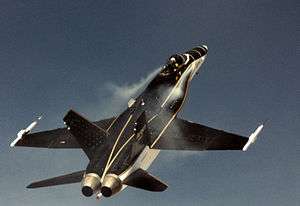High Alpha Research Vehicle
| F-18 High Alpha Research Vehicle (HARV) | |
|---|---|
 | |
| F-18 HARV in high alpha maneuver | |
| Role | Test aircraft |
| Manufacturer | McDonnell Douglas |
| Primary user | NASA |
| Number built | 1 |
| Developed from | McDonnell Douglas F/A-18 Hornet |
The High Alpha (angle of attack) Research Vehicle was an American modified McDonnell Douglas F/A-18 Hornet used by NASA in a 3-phase program investigating controlled flight at high angles of attack using thrust vectoring, modifications to the flight controls, and with actuated forebody strakes. The program lasted from April 1987 to September 1996.[1][2]
NASA reported that in one phase of the project, Armstrong Flight Research Center "research pilots William H. "Bill" Dana and Ed Schneider completed the envelope expansion flights in February 1992. Demonstrated capabilities included stable flight at approximately 70 degrees angle of attack (previous maximum was 55 degrees) and rolling at high rates at 65 degrees angle of attack. Controlled rolling would have been nearly impossible above 35 degrees without vectoring."[3] Performance figures were not listed for other phases.
See also
- Related development
| Wikimedia Commons has media related to High Alpha Research Vehicle. |
References
- ↑ Jenkins, Dennis R. (2000). F/A-18 Hornet: A Navy Success Story. New York: McGraw-Hill. ISBN 0-07-134696-1.
- ↑ F-18 High Alpha Research Vehicle (HARV) fact sheet, NASA/Dryden Flight Research Center.
- ↑ NASA Past Projects: F-18 High Alpha Research Vehicle, NASA
External links
- Overview of HATP Experimental Aerodynamics Data for the Baseline F/A-18 Configuration, NASA, September 1996.
- Preparations for flight research to evaluate actuated forebody strakes on the F-18 high-alpha research vehicle, NASA, July 1994.